For now, at least, this blog is not being updated. Thanks for reading. If you’d like to be in touch, please send an email. If I’ve got something to say it’ll be at rogerpielkejr.com.
Author: rogerpielkejr
Pielke on Climate #13

Welcome to issue #13 of my occasional newsletter on climate and energy issues. As a reminder, my day-to-day research and teaching is primarily focused on sports governance and various issues of science policy. But I’ve written a fair bit on the topics of climate and energy over the past 25 years, including two recent books and a boatload of academic papers.
Now that I’m no longer being investigated by Congress, the subject of a billionaire’s delegitimization campaign or receiving threats I’ve decided to start again writing a bit more on climate issues. So caveat lector!
A few things to say up front:
- If you appreciate the perspective, consider the tip jar to your right.
- These funds continue to help me defray the costs of several trips where I have had the chance to develop and present new talks. I am otherwise unfunded on this topic.
- As such, contributions are much appreciated and will be put to professional use.
- If you don’t like what I write or don’t like me, then don’t read what I write – no big deal, I’m just a professor with a blog.
- On the other hand, if you’d like to engage, consider a comment, Tweet @ me (@rogerpielkejr) or send an email. I am happy to discuss or debate. I’ve had great feedback on these newsletters so far.
- Social media warning: I’m happy to engage with anyone, but if you choose to tone troll me, call me names or lie about my views or writings (oh-so-common in discussing climate), then you will be muted or ignored. I am blocked on social media by some academics and journalists in the climate area and if you’d prefer not to see the views I present, there is always that option.
- Also, if you have a pointer or tip on climate science or policy, please send that along as well. Anonymity guaranteed for those who want it.
- Lastly, thank you for reading!
With that . . . this month I focus on disasters.
The Rightful Place of Science: Disasters & Climate Change, 2nd Edition
- My short book in the ASO/CSPO series has been comprehensively updated and revised. It has gone to press and will be available soon.
- You can pre-order it from Amazon here.
- If you are teaching a relevant course, I am happy to schedule a Skype lecture or discussion with your students. Just send me an email and we will sort things out.
- In the book are updated data on tropical cyclones, tornadoes, floods and drought. I also discuss the science of detection and attribution as performed under the IPCC, the unwise abandonment of the D&A IPCC framework in favor of event attribution studies, as well as a discussion of climate policy more generally.
WSJ: Some Good News–About Disasters of All Things

- Last week I had an op-ed in the WSJ on global disasters, available here
- Here is how I start:
- “In his posthumously published book “Factfulness,” the Swedish statistician Hans Rosling describes a paradox: “The image of a dangerous world has never been broadcast more effectively than it is now, while the world has never been less violent and more safe.” A case in point: natural disasters. The earth will always be volatile, but despite recent fires, volcanoes and hurricanes, humanity currently is experiencing a stretch of good fortune when it comes to disasters.”
- In it I observe the remarkable decline in lives lost to disasters over the past half century, a drop of 80%. There is still more to do, and vulnerabilities remain, but progress has been huge, and it is OK to say so.
- I also observe that losses (direct economic damage) have also decreased since 1990, when global data coverage allows for a reliable assessment. This too is good news.
- Disaster losses as a proportion of global GDP is an indicator to be tracked under the UN Sustainable Development Goals. I’ve got a paper on this topic presently under review.
Some Recent Papers I’ve Been Reading on Disasters and Extreme Weather
- Earl, N., & Simmonds, I. (2018). Spatial and temporal variability and trends in 2001–2016 global fire activity. Journal of Geophysical Research: Atmospheres, 123(5), 2524-2536.
- “There is a very strong decline in global fires (stat sig at the 0.1% confidence level; hereafter p < 0.001), present in each season except Dec–Feb (p < 0.1)” [see figure below]
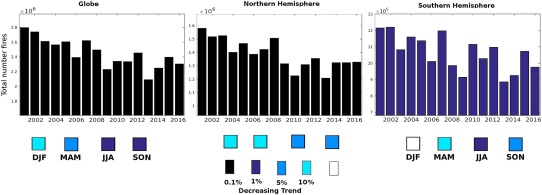
- Regional trends are also interesting: “most of these large‐scale regions of the world exhibit little change or decreasing in fire activity except India (box 14) and China (box 17—…), with a weak nonsignificant signal in Canada” [see figure below]
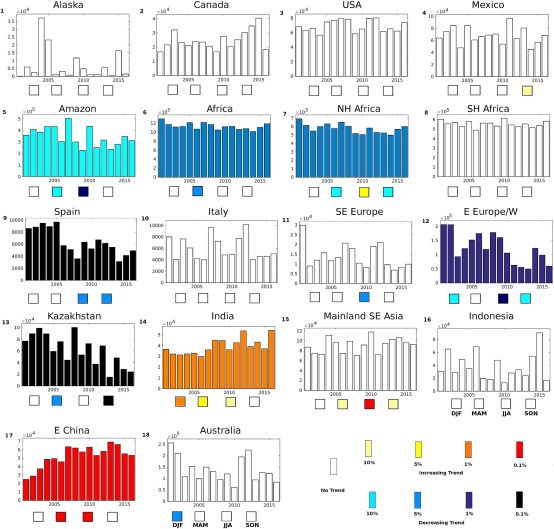
- I’ll offer a brief editorial comment on this paper. The contrast between what this data shows and the public statements by some prominent climate scientists is jarring. Fires are not more common, in fact the data indicates the opposite.
- Of the US the authors write: “”The mainland United States (box 3) displays no 2001–2016 trend in [active fires] … This is also the case for the satellite‐based [burned area] studies (Andela et al., 2017; Giglio et al, 2013), though BA has been found to be increasing in some surface‐based U.S. studies (see Doerr & Santín, 2016). This is surprising, as the economic costs of wildfire in the United States have risen substantially in recent decades and from 1992 to 2012, with anthropogenically ignited wildfires accounting for 84% of all wildfires.”
- The case of fires appears quite similar to that of tropical cyclones in which every visceral tragedy is exploited by a few prominent activist scientists and journalists to suggest that things are getting worse, when in fact the evidence indicates that the opposite is true.
- I have come across two new papers that seek to normalize economic losses from tropical cyclones in China.
- Chen, Wenfang, et al. (2018). Hazard Footprint-Based Normalization of Economic Losses from Tropical Cyclones in China During 1983–2015. International Journal of Disaster Risk Science, 1-12.
- This analysis finds that normalized losses declined over the period 1983 to 2015, see figure below.

- Ye, Y., & Fang, W. (2018). Estimation of the compound hazard severity of tropical cyclones over coastal China during 1949–2011 with copula function. Natural Hazards, 1-17.
- This paper looked at time series in maximum wind speed and total precipitation over the period 1985 to 2011, finding no trends. See figure below.
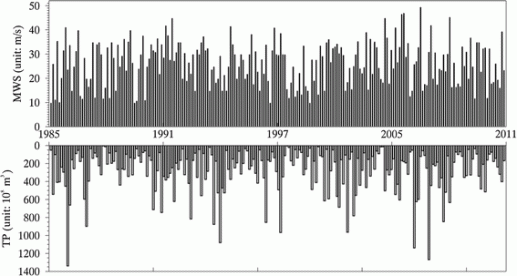
- The paper also presented data on normalized losses, also finding a decrease over the period of study, see figure below.
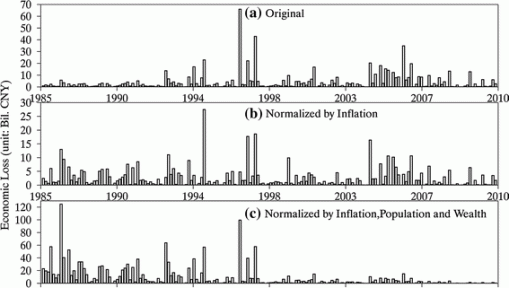
- The trends in normalized documented in these two papers are consistent with trends observed in other ocean basins around the world as well as the overall decrease in disasters losses as a proportion of global GDP.
- Chen, Wenfang, et al. (2018). Hazard Footprint-Based Normalization of Economic Losses from Tropical Cyclones in China During 1983–2015. International Journal of Disaster Risk Science, 1-12.
- Boccard, N. (2018). Natural disasters over France a 35 years assessment. Weather and Climate Extremes.
- “the incidence of floods over mainland France is found to be stable over the last 35 years and even falling once we account for the heightened population pressure” [see figure below]

- “rates of forest fire destruction display a significative downward trend, the anthropogenic rate fell from about 5% to 2% (over the period 1973–2017) while the natural rate is about 100x smaller and likewise falling.”
- “The latter fact proves that the incidence of natural forest fires over the French mediterranean seaboard is receding over the last 44 years.”
- The bottom line? The scientific literature on disasters and climate change continues to be at extreme odds with frequent public representations found in the media and put forward by some leading scientists.
Pielke on Climate #12
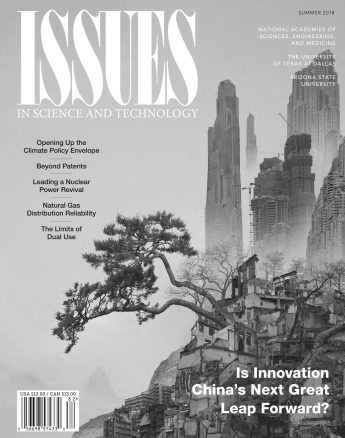 Welcome to issue #12 of my occasional newsletter on climate and energy issues. As a reminder, my day-to-day research and teaching is primarily focused on sports governance and various issues of science policy. But I’ve written a fair bit on the topics of climate and energy over the past 25 years, including two recent books and a boatload of academic papers.
Welcome to issue #12 of my occasional newsletter on climate and energy issues. As a reminder, my day-to-day research and teaching is primarily focused on sports governance and various issues of science policy. But I’ve written a fair bit on the topics of climate and energy over the past 25 years, including two recent books and a boatload of academic papers.
Now that I’m no longer being investigated by Congress, the subject of a billionaire’s delegitimization campaign or receiving threats I’ve decided to start again writing a bit more on climate issues. So caveat lector!
A few things to say up front:
- If you appreciate the perspective, consider the tip jar to your right.
- These funds continue to help me defray the costs of several trips where I have had the chance to develop and present new talks. I am otherwise unfunded on this topic.
- As such, contributions are much appreciated and will be put to professional use.
- If you don’t like what I write or don’t like me, then don’t read what I write – no big deal, I’m just a professor with a blog.
- On the other hand, if you’d like to engage, consider a comment, Tweet @ me (@rogerpielkejr) or send an email. I am happy to discuss or debate. I’ve had great feedback on these newsletters so far.
- Social media warning: I’m happy to engage with anyone, but if you choose to tone troll me, call me names or lie about my views or writings (oh-so-common in discussing climate), then you will be muted or ignored. I am blocked on social media by some academics and journalists in the climate area (e.g., Mann, Hayhoe, Brulle, Mooney, Gillis …) and if the views I present are just too disturbing, there is always that option. It’s OK, such action by professionals says more about the blocker than about my views.
- Also, if you have a pointer or tip on climate science or policy, please send that along as well. Anonymity guaranteed for those who want it.
- Lastly, thank you for reading!
With that . . .
Opening Up the Climate Policy Envelope
I have a new paper out today in Issues in Science and Technology. The paper is freely available here in PDF. Here is the citation:
- R. Pielke Jr., “Opening Up the Climate Policy Envelope,” Issues in Science and Technology 34, no. 4 (pp. 30-36, Summer 2018).
Please do visit Issues online here for lots of excellent writing on topics in science and technology policy. You can also follow them on Twitter @ISSUESinST.
The paper is my first major climate policy paper since The Climate Fix. In it I seek to unravel (at least a part of) what has been a long-time policy puzzle: Why is it that after more than 25 years of failure in climate policy leaders in the climate movement continue to pursue essentially the same strategies that have failed over and over?
To be very clear, by “failures in climate policy” I am referring narrowly to efforts to accelerate decarbonization of the global economy, which is technically the ratio of carbon dioxide emissions to GDP. Of course climate policy writ large has achieved many things, often positive. But evidence indicates that accelerating the rate of global decarbonization is not among these things.
Here is evidence for the claim of climate policy failure (more details in Issue #11).
Looking more closely at the relevant levers of the Kaya Identity, it is easy to see that neither energy intensity nor carbon intensity has seen an acceleration in their decline in the era of global climate diplomacy. (In the case of carbon intensity, there hasn’t even been a decline in recent decades.) More discussion can be found in Issue #11.
Evidence of policy failure to date seems unambiguous.
In my new paper I describe the concept of a “policy envelope” analogous to the idea of a “flight envelope”:
For an aircraft to fly it must operate within a flight envelope, the combination of conditions such as airspeed, altitude, and flight angle necessary for successful
operation. For a specific approach to climate action to succeed, it must operate within a policy envelope, the combination of policy design and political, economic, technological, and other conditions necessary for the approach to be effective.
In climate policy, for decades enormous effort has been expended in protecting the “policy envelope” of possibilities, the outcome of which might be called policy lock -in. Part of the dynamics at play here of course has been the effort to scientize the issue by making it about belief in the catastrophic potential of human-caused climate change. Hence the tiresome name-calling and sometimes cult-like proselytizing: Denier! Alarmist! Climate Disinformer! This is part of the story, and perhaps the most obnoxious, but probably is not the most important. These dynamics are not the focus of my paper.
My paper takes a look at a more subtle, more technical and arguably more consequential mechanism for the policy lock-in that characterizes climate policy. That mechanism is the role of integrated assessment models and the assumptions that underpin them in creating a restricted policy space for considering alternative policy actions. Remarkably, that policy space has narrowly centered on climate policy business as usual (that is the FCCC, Kyoto, Paris) and excluded alternative approaches even as evidence accumulates that what the world is doing is not bearing much fruit.
My paper highlights a few of these important assumptions, which are well past the point of looking fantastical in the sense that if you are aware of them, you really cannot believe that they are remotely plausible. It thus takes some serious effort in denial — the far more important form of climate denial I argue — to advocate climate policy business as usual with a straight face.
I argue for opening up the policy envelope to consider a wide range of new possibilities in hopes that climate policy might perform better than it has in the past.
I wrote the paper to be read, to be debated, to be argued over. So I’d welcome your comments and questions, here or on Twitter @RogerPielkeJr.
Once again, thanks for reading!
Pielke on Climate #11

Welcome to issue #11 of my occasional newsletter on climate and energy issues. As a reminder, my day-to-day research and teaching is focused on sports governance and various issues of science policy. But I’ve written a fair bit on the topics of climate and energy over the past 25 years, including two recent books and a boatload of academic papers.
So caveat lector!
A few things to say up front:
- If you appreciate the perspective, consider the tip jar to your right.
- These funds continue to help me defray the costs of several trips where I have had the chance to develop and present new talks. I am unfunded on this topic.
- As such, contributions are much appreciated and put to professional use.
- If you don’t like what I write or don’t like me, then don’t read it – no big deal, I’m just a professor with a blog.
- If you’d like to engage, consider a comment, Tweet @ me (@rogerpielkejr) or send an email. I am happy to discuss or debate. I’ve had great feedback on these newsletters.
- Social media warning: I’m happy to engage with anyone, but if you choose to tone troll me, call me names or lie about me, oh-so-common in discussing climate, then you will be muted or ignored. I am blocked on social media by some academics and journalists in the climate area (e.g., Mann, Hayhoe, Brulle, Mooney, Gillis …) and if the views I present are too disturbing, there is always that option. It’s OK, such action by professionals says more about the blocker than about my views.
- Also, if you have a pointer or tip on climate science or policy, please send that along as well. Anonymity guaranteed for those who want it.
- Lastly, thank you for reading!
With that . . .
7 Things Everyone Should Know About Climate
Last week in Tokyo I participated in the 3rd Annual IEEJ/APERC Joint International Energy Symposium. The large conference is great for me because I get to learn a lot from experts in global energy. I also had a chance to give a talk.
My talk focused on seven things that I believe everyone engaged in climate policy should know about the issue. In a longer talk I could have listed 20 things and a shorter one 3. And there is of course valid debate about what might be considered most important, but these are the seven I presented this week. I welcome comments, questions, critique.
- Here are the seven things summarized, and below I’ll say a bit about each.

- Economic damage from weather disasters as a proportion of global GDP has decreased since 1990

The reduction of direct economic losses from disasters as a proportion of global GDP has been highlighted as a policy indicator by the UN under its SDGs. So it is important to track and understand. Below are data for weather disasters (i.e., no earthquakes, tsunamis in particular).
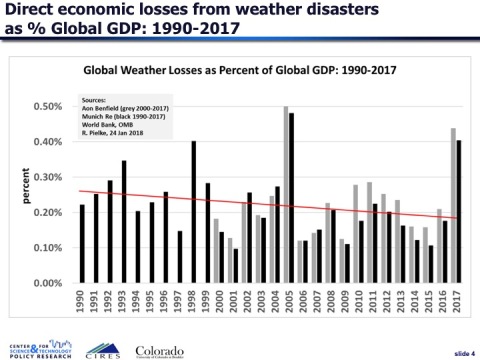
More detail on this graph and the science behind it, including data and peer-reviewed research can be found at this post. When I share this data I hear expressions of surprise and, not infrequently, even shock. This data shows good news. We should understand why the trend is occurring and how we might keep it going.
- Climate impact studies favor an extreme, implausible scenario for the 21st Century (RCP 8.5)

Readers here will know that I’ve discussed this issue extensively. The issue here is that not RCP 8.5 is being used, it is that the scenario is often characterized as business-as-usual or a likely future, when it is in fact an extreme outlier. As an extreme outlier it should not be the most commonly used scenario in climate impact models (below, upper left graph).
RCP 8.5 also dominates media and policy discussions of climate impacts. This over-representation, I hypothesize, is an important reason that many people are surprised to learn that weather disasters are decreasing as a proportion of GDP. A steady diet of “climate porn” is sure to warp one’s views about what is actually happening. Here are just a few recent headlines originating in RCP 8.5 climate impact studies. I’ll discuss this issue in more depth in a forthcoming paper.

- Almost all stabilization scenarios of IAMs used by the IPCC depend on the wide deployment of technologies that do not exist (BECCS)

This point cannot be emphasized too strongly, and I have a forthcoming paper that will discuss this issue further. The Paris Agreement target of well-below 2.0 degrees C that nations have committed to achieving depends upon a policy option found in science fiction. If there ever was an “Emperor’s New Clothes” moment in climate policy (and there are many candidates), this is it. Some experts have been raising this issue, Oliver Geden and Glen Peters among them, but the essential role of BECCS in climate policy scenarios still does not have wide understanding in climate policy discussions. It should.
- There is little evidence that climate policy since 1992 has influenced global decarbonization rates (CO2/GDP)

If you really want to understand climate policy (as related to carbon dioxide), then you need to understand the Kaya Identity. My book on climate policy, The Climate Fix, centers on the Kaya Identity and explains why it is so important and powerful. It is summarized above, which shows that a reduction in the ratio of carbon dioxide emissions to GDP is decarbonization. Success or lack thereof in carbon policies should focus on this metric and not simply emissions.

The data above, which comes from the International Energy Agency (historical) and PwC (future), comes as a surprise to many people. It shows that decarbonization rates have not changed from before the climate policy era (1971-1992: 1971 is the start of the IEA dataset and 1992 is the year of the Rio Convention) to after it began (measured as after Rio 1992 or after Kyoto 1997). Here are data for individual countries and the world since 2000. Each nation has its own story, which can be spun as more or less successful. But if we are being honest with ourselves, none is remotely close to what is needed according to the targets that these countries have putatively agreed to meet.

After my talk last week several people commented along the lines of, “Yes decarbonization has not increased, but climate policy has done X, Y or Z …”. This is true. Climate policy has led to many outcomes. But we also need to understand that influencing the rate of decarbonization of the global economy is not among those outcomes. This is hard medicine to swallow, as the needed rate to achieve the targets of the Paris Agreement are more than four times faster than what has occurred over most of the past half century. What we are doing is not working and claims that success is just around the corner are just not believable.
- The most important lever for deep decarbonization is carbon intensity (CO2/TPES)

The mathematics of deep decarbonization of the sort envisioned under the Paris Agreement are really very simple. The world needs to source >90% of its energy consumption from carbon-free sources by sometime this century. This needs to be earlier depending on how stringent a concentration target (e.g., 450 ppm) is desired to be met. The 90%+ level of carbon-free energy is completely insensitive to how much energy is ultimately consumed. In technical terms, whatever is done on energy intensity (of GDP) success will be a function of progress in carbon intensity (of energy). This is just math. Don’t just take my word for it, do the math yourself.
The Kaya Identity again explains why carbon intensity is so important. Elsewhere I’ve explained why using GDP as a lever to accelerate decarbonization is not going to happen, the so-called Iron Law of Climate Policy.
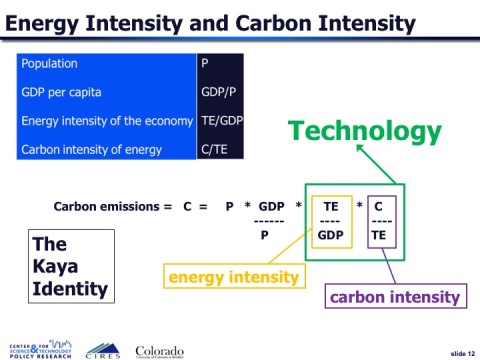
So how is the world doing on carbon intensity and energy intensity? Have a seat and look at these data from IEA.

Thee data clearly explain the lack of progress in overall decarbonization: energy intensity decline, a good thing indeed, has proceed at more-or-less a constant rate since 1971. Carbon intensity hasn’t much budged — remarkably, carbon intensity in 2015 was the same as it was in 1985. The last time carbon intensity declined was during the era of the rapid expansion of nuclear power in the 1970s. On the figure above, carbon intensity in 2015 sits at about 100 (with 1990 = 100); meeting the target of the Paris Agreement requires that it fall to below 10. Again, just math.
Here is another way to quantify the size of the challenge in somewhat less abstract terms.
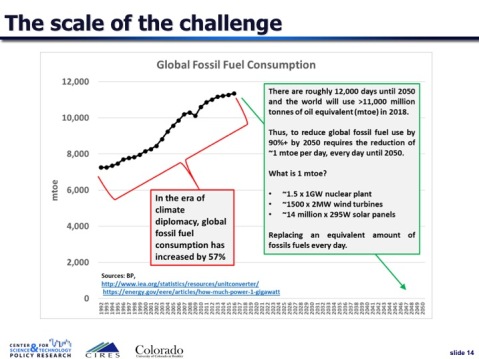
- US Climate policy is subject to dramatic shifts because, since the 1990s, US climate policy has occurred via executive action rather than Congressional legislation

This point is mainly for an international audience, but should also be appreciated in the US. It is my firmly held view that the US will be incapable of substantially accelerating decarbonization rates over many years or decades until it is able to secure broad, bipartisan Congressional support for that goal. The alternative will be the political whiplash and inconsistencies observed since 1992, with the occasional surprise (hey, shale gas!). A short-termist perspective tends to reinforce the partisan nature of the US climate debate as activists rush to reverse the most recent executive action (e.g., Keystone pipeline) via electoral victories rather than do the hard work of building a meaningful, bipartisan coalition that is robust to the inevitable political swings. I am not too optimistic that this will change any time soon.
- The IPCC does not serve as an “honest broker of policy alternatives” — but it should

If you get the sense from the slides above that the world is not doing so great on climate policy, you’d be correct. In such a situation we might think that we’d be engaged in an intensive search for new alternatives, new options to break out of the current state of poor performance. You’d think, huh?
The IPCC is important and if it didn’t exist we’d have t invent it (as I explained to the US Congress last year), but its role in policy is less helpful than it might be. The IPCC should encourage the exploration of possibilities, the opening up of policy debate and discussion and the introduction of new possibilities into politics. Instead, the IPCC serves to reinforce the very policies that are not succeeding (e.g. BECCS!) and in doing so, actually promotes the status quo. Working Group 3 (or a new Working Group 4) should explicitly discuss policy options. Without good alternatives, we will go exactly where we are headed.
- So that is it. Here the seven things everyone should know about climate policy and how you can learn more. Feel free to comment below on this post or via Twitter @rogerpielkejr.


Pielke on Climate #10
 Welcome to issue #10 of my occasional newsletter on climate and energy issues. As a reminder, my day-to-day research or writing is focused on sports governance and various issues of science policy. But I’ve written a fair bit on the topics of climate and energy over the past 25 years, including two recent books and a boatload of academic papers, and I’m paying attention.
Welcome to issue #10 of my occasional newsletter on climate and energy issues. As a reminder, my day-to-day research or writing is focused on sports governance and various issues of science policy. But I’ve written a fair bit on the topics of climate and energy over the past 25 years, including two recent books and a boatload of academic papers, and I’m paying attention.
So caveat lector!
A few things to say up front:
- If you appreciate the perspective, consider the tip jar to your right.
- Thanks to those of you who have already contributed!
- These funds continue to help me defray the costs of several trips where I have had the chance to develop and present new talks. I am unfunded on this topic.
- Contributions are much appreciated.
- If you don’t like what I write or don’t like me, then don’t read it – no big deal, I’m just a professor with a blog.
- If you’d like to engage, consider a comment, Tweet @ me (@rogerpielkejr) or send an email. I am happy to discuss or debate. I’ve had great feedback on these newsletters.
- Also, if you have a pointer or tip, please send that along as well. Anonymity guaranteed for those who want it.
- Social media warning: if you choose to call me names or lie about me, oh-so-common in discussing climate, then you will be muted or ignored.
With that . . .
Talk on “Extreme Weather and Extreme Politics”
- Earlier this month I gave a talk at the University of Minnesota.
- It was my first public talk on climate since being “investigated” by Rep. Raul Grijalva (D-AZ) in 2015.
- It is also the first and only invitation I’ve received to give a public talk on climate at a US university since 2015.
- Before that I received about 2-3 invitations per month.
- Delegitimization works.
- You can see my slides from Minnesota at
- Much of what I presented (and more) will appear in the 2nd edition of Disasters and Climate Change.
- Below I document a key episode in my own experience that I have never looked back on in detail.
- The timeline is of use to me, shared here for anyone else who might be interested.
A Look Back at the Holdren-Pielke Debate of 2014
- One of the more bizarre experiences I’ve had in the climate debate was when President Obama’s science advisor, John Holdren, posted a weird, 6-page screed about me on the White House web site.
- Here is a reconstruction of and look back at those events, and an evaluation how they look from vantage point of 2018.
- This look back is mainly just for me, as when you are in the spin cycle it can be hard to see what has happened at the time.
- The Holdren episode ultimately led to me being investigated by a member of Congress with a major impact on my life and career.
- I’ve not taken a close look back at this episode, it’s time for me to document exactly what transpired. If you are not interested, this would be a good place to take the exit ramp.
- In July 2013, I testified before the US Senate Environment and Public Works Committee on extreme events.
- You can see my 5 minute statement below and read my full written testimony here in PDF. That testimony was widely discussed.
- I followed that testimony up with similar testimony before the US House a few months later, in October 2013.
- I wrote a blog post explaining that the science on these issues was solid. Even so I argued that “zombie science” (to the contrary) would always be with us.
- On February 14, 2014, Holdren was quoted as saying: “We really understand a number of the reasons that global climate change is increasing the intensity and the frequency and the life of drought in drought-prone regions. This is one of the better-understood dimensions of the relationship between global climate change and extreme weather in particular regions. . . There are other, more subtle, ways climate change may be affecting the prevalence of drought; scientists are still arguing about those. The three I just described are more than enough to understand why we are seeing droughts in drought-prone regions becoming more frequent, more severe and longer.”
- Two weeks later Dr. Holdren was asked about these statements by Senator Jeff Sessions before the Senate Environment and Public Works Committee, the same committee that I had testified before the previous July.
- The full exchange between Sessions and Holdren can be found here, but below are the key excerpts.
- After some sparring on what Dr. Holdren said or didn’t say a few week previous, Senator Sessions said:
- “Well, let me tell you what Dr. Pilkey (sic) said, who sat in that chair you are sitting in today just a few months ago, he is a climate impact expert, and he agrees that warming is partly caused by human emissions. But he testified “It is misleading and just plain incorrect to claim that disasters associated with hurricanes, tornadoes, floods or droughts have increased on climate change time scales either in the United States or globally.”
- Holdren replied with a delegitmization effort, saying that I was
- “not representative of the mainstream scientific opinion on this point. And again, I will be happy to submit for the record recent articles from Nature, Nature GeoScience, Nature Climate Change, Science and others showing that in drought-prone regions droughts are becoming more intense.”
- Of course, Holdren was incorrect.
- My views are 100% consistent with those of the IPCC, the very definition of “mainstream scientific opinion.”
- Holdren promised to submit scientific evidence for the hearing record in support of his views, Sessions said he looked forward to it.
- Three days later Holdren’s missive about me was posted on the White House website, titled Drought and Global Climate Change: An Analysis of Statements by Roger Pielke Jr ” (here in PDF).
- Holdren singled out just 2 statements that I had made in my testimony:
- “It is misleading, and just plain incorrect, to claim that disasters associated with hurricanes, tornadoes, floods or droughts have increased on climate timescales either in the United States or globally.”
- Drought has “for the most part, become shorter, less, frequent, and cover a smaller portion of the U.S. over the last century”. Globally, “there has been little change in drought over the past 60 years.”
- The quotes in blue above are from the US National Climate Assessment (former) and a Nature paper (latter) on global drought trends.
- Holdren explained his objections:
- “I replied that the indicated comments by Dr. Pielke … were not representative of mainstream views on this topic in the climate-science community; and I promised to provide for the record a more complete response with relevant scientific references. “
- The slide below shows the entirety of my discussion of drought in my 2013 Senate testimony, which consisted only of quotes from the IPCC, the US CCSP and an image from the CCSP report.

- Holdren did not mention hurricanes, floods or tornadoes in his 6 pages of response.
- Holdren’s response blew up the internet (or at least the tiny part of it involving issues related to climate).
- When the White House posts 6 pages about you, it gets noticed.
- For my part, in response wrote a blog response which you can read here.
- In that post I noted:
- “It is fine for experts to openly disagree. But when a political appointee uses his position not just to disagree on science or policy but to seek to delegitimize a colleague, he has gone too far.”
- This was, as far as I am aware, the first time that a Science Advisor to the US President used his platform to seek to delegitimize an academic with whom he disagreed.
- I am aware of no such comparable use of the authority and reach of the White House against a researcher.
- The fact that I was singled out by the president’s science advisor was not reported on or commented on by the mainstream scientific media. Leading scientific organizations said nothing.
- I found this pretty amazing, but c’est la vie.
- If John Marburger, say, had gone after James Hansen, it’d have been a story.
- I responded more forcefully in an article in The New Republic a few days later.
- None of this mattered, I quickly learned that a lone academic is no match for the bully pulpit that is the White House and the powerful echo chamber of the online climate debate.
- A few weeks later the campaign to have me removed as a writer for 538 was underway and 11 months later the investigation motivated by Rep. Raul Grijlava (D-AZ), which he indicated was the result of Holdren’s missive, was launched.
- One of my close colleagues said to me at the time: “I’d love to come to your defense, but I don’t want them coming after me.”
- Fair enough.
- Let’s quickly take a look at the state of the science in 2018 on drought.
- The 2017 US National Climate Assessment, prepared under the direction of John Holdren in the last months of the Obama Administration and released after Donald Trump became president concluded the following about drought:
- “drought statistics over the entire CONUS have declined … no detectable change in meteorological drought at the global scale”
- “Western North America was noted as a region where determining if observed recent droughts were unusual compared to natural variability was particularly difficult.”
- Right.
- It was an interesting experience.
- I’m still here.
CAP Backs Down When Challenged

Judd Legum is an editor for the Center for American Progress, where he oversees their “Climate Progress” blog. Over the years, in his role as editor he oversaw or wrote some 160+ articles about me on their pages, misrepresenting my research and political views. After I wrote an article for Natre Silver at 538 in 2014, he called up Silver (and Silver’s lead editor) to demand I be fired. In 2016, the Wikileaks releases revealed Legum was misrepresenting my work as part of a political campaign on behalf of billionaire Tom Steyer. But that embarrassment hasn’t kept Legum away, just yesterday he again took to Twitter to misrepresent my academic work. It’s always the same playbook.
I’ve had enough of CAP and their lies, misrepresentations and character assassination. So yesterday I challenged Legum to back up his Twitter and Wikileaks bravado in a public debate with me. If my work has been “comprehensively debunked” by CAP and is the work of “deniers” then he should be able to destroy me in a public forum, giving a powerful lesson to anyone foolish enough to challenge him.
Here is how Legum responded in declining the opportunity to debate the subject of my 538 article that has had him so worked up over these past four years:
I think on the topic, the idea of what’s driving the costs of disasters is a technical topic that would not create a compelling public debate. The arguments all hinge on data analysis that would be boring and no readily comprehensible for a general debate.
Say what? A “technical topic”? And “not readily comprehensible”? So much for the Wikileaks bravado about debunking my work and all that.
More generally Legum responded:
I’m not sure you actually stake out any such positions that I disagree with.
This is a remarkable admission from the guy at the Center for American Progress who has overseen a decade-long effort to destroy my academic career through social media bullying, behind the scenes politicking and the spreading of outright lies. It also shows what happens when bullies are challenged but can’t back it up. They back down and slink away.
Public Debate Challenge to Judd Legum

People are funny. Judd Legum is a die-hard partisan who works for the Center for American Progress. For some reason, four years ago he decided to use his position to (successfully) get me removed as a writer for 538. You all know the story.
Well Judd is back to harass. Apparently more than 160 articles about me at CAP were not enough.
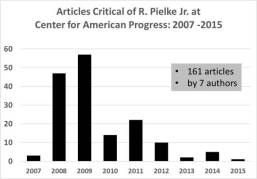
Well, I’ve long had enough abuse and bullying from these guys. So Judd, rather than you sniping at me on Twitter with lies and innuendo, let’s do this in person and for real. Let’s debate the issues that you profess to care so deeply about, and that I am so wrong about, in a public forum. Should be an easy win for you.
OK@juddlegum of the Center for American Progress persists with an aging smear campaign against me.
Let’s cut to the chase.
I challenge him to a public debate on climate science & policy.
Please spread this far and wide.
Let’s see if he can back up his Wikileaks🙏
I’m ready Judd. https://t.co/c72XwXm1ho— Roger Pielke Jr. (@RogerPielkeJr) April 5, 2018
I have no doubt we can use the event to raise money for important charities. Mine will be Doctors Without Borders.
Judd, whenever convenient, I’ll come to you. You can come here. Whatever.
What do you say? You got some substance behind the Wikileaks and Twitter bravado?
It’s guaranteed he will decline the offer. And that will tell you all you need to know.
Why Look at Global Disaster Losses as a Proportion of Global GDP?
 The graph above shows global weather disasters as a proportion of global GDP. It does not include earthquakes, tsunamis or other non-weather/climate related events. I am sometimes asked: why focus on a metric of global disaster losses as a proportion of global GDP?
The graph above shows global weather disasters as a proportion of global GDP. It does not include earthquakes, tsunamis or other non-weather/climate related events. I am sometimes asked: why focus on a metric of global disaster losses as a proportion of global GDP?
The short answer is that this metric says something about the relative impacts of disasters in the broad context of the global economy. Economists and policy analysts routinely use GDP as a denominator to understand the economy-wide significance of variables such as government spending, health care costs, R&D spending, etc.
If disaster losses are growing as a proportion of GDP it would mean that the world is losses are increasing as a proportion of global economic activity, surely a bad sign. Alternatively, if disaster losses are shrinking as a proportion of GDP, it would indicate that disaster losses are less significant in context of global economic activity, surely a positive sign.
It is this logic which underpins the inclusion of disaster losses as a proportion of GDP as an indicator of the UN Sustainable Development Goals and targets of the 2030 Agenda for Sustainable Development.
Disasters as proportion of GDP appear under:
- Goal 1: End poverty in all its forms everywhere
- Goal 11. Make cities and human settlements inclusive, safe, resilient and sustainable
The overarching goal is to “substantially decrease the direct economic losses relative to global gross domestic product caused by disasters.” This is why we look at global disasters as a proportion of global GDP. It is not the only important indicator, but it is one.
Of course, if you want to understand how changes in climate may be reflected in the trends in the intensity or frequency of extreme weather, don’t look at economic data. Look at weather and climate data directly.
Statement on a False Claim of Contribution by The Heartland Institute

UPDATE: I received the email above from the president of the Heartland Institute. I appreciate his speedy and positive response to my request. Michael E. Mann has not corrected the record and leaves his Tweets on this up.
It has been called to my attention that I am listed in a report by the Heartland Institute as a member of a task force of theirs and contributor to a new report. This is false in both instances.
I have never had a relationship with The Heartland Institute and never will. Heartland has once before falsely listed me on their website as a collaborator. They took it down when requested.
I have emailed Heartland Institute to demand that they remove my name from the report and also apologize for the false claim.
In parallel, climate scientist Michael E. Mann is using his platform to spread the misinformation. I have emailed Prof. Mann to ask that he stop spreading the false information. Fifteen minutes after receiving my email Mann again Tweeted the false information, and as of this writing has repeated the false information in four seven nine fourteen subsequent Tweets.
This is incredibly unethical behavior by Heartland and Mann. I am requesting that both stop and act positively to correct the factual record. Twitter spreads misinformation quickly. Do the right thing.
Pielke on Climate #9
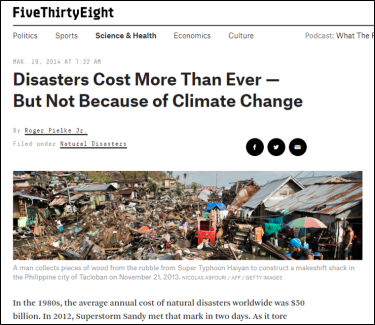
There was collusion. The image above of course comes from my infamous article that led the Center for American Progress to orchestrate a well-organized campaign to have me fired as a writer for FiveThirtyEight. Bizarrely, that campaign against me came to light via John Podesta’s hacked emails, released by Wikileaks during the 2016 presidential campaign. Below, I’ll share some new research on floods and tropical cyclones which further buttress the findings of that 2014 article that caused so much of a stir. It’s still as scientifically accurate today as it was then. Facts first.
Welcome to issue #9 of my occasional newsletter on climate and energy issues. As a reminder, my day-to-day research or writing is focused on sports governance and various issues of science policy. But I’ve written a fair bit on the topics of climate and energy over the past 25 years, including two recent books and a boatload of academic papers, and I’m paying attention. So caveat lector!
A few things to say up front:
- If you appreciate the perspective, consider the tip jar to your right.
- Thanks to those of you who have already contributed!
- These funds have helped me defray the costs of several trips where I have had the chance to develop and present new talks related to climate.
- If you don’t like what I write or don’t like me, then don’t read it – no big deal, I’m just a professor with a blog.
- If you’d like to engage, consider a comment, Tweet @ me (@rogerpielkejr) or send an email. I am happy to discuss or debate. I’ve had great feedback on these newsletters.
- Also, if you have a pointer or tip, please send that along as well. Anonymity guaranteed for those who want it.
- Social media warning: if you choose to call me names or lie about me (looking at you Michael E. Mann, Justin Gillis), oh-so-common in discussing climate, then you will be muted or ignored.
With that . . .
Upcoming Talk at the University of Minnesota
- On April 18th at 7pm I’m giving a talk at the University of Minnesota
- The title is “Extreme Weather and Extreme Politics” and here is a short abstract:
- In 2017, three major hurricanes struck the United States, causing as much as $200 billion in damage and considerable loss of life. Whenever extreme weather events occur, assertions are made about possible connections to human-caused climate change. We need not rely on assertions as there is a robust body of research and evidence available. I’ve studied extreme weather the damage that it causes for the past 25 years. I’ve also had a front row seat to the so-called “climate wars” — the highly politicized, often nasty and always passionate debate over human-caused climate change. This talk will present consensus science and data on the role of human-caused climate change in trends in the frequency and intensity of extreme weather, in the United States and around the world. I’ll also describe the significant challenges I faced in simply trying to present this science to policy makers and the public. The bottom line? Scientific integrity matters, regardless of your politics. All sides in the climate debate should do better. I’ll suggest how.
- I’ll post up more details as they are available, and slides and video after.
- Follow me on Twitter for updates
Are We Finally Moving Past the Delegitimization of Climate Realism?

- Last month I posted up some slides illustrating the actual scale of the challenge of decarbonizing the global economy to a level consistent with low concentrations of carbon dioxide in the atmosphere, 450 ppm or lower. See above also.
- The 450 ppm level is consistent with the oft-discussed, little understood 2 degree Celsius temperature target.
- I’m not alone in pointing out the “Emperor’s new clothes” tenor to much of climate discussions.
- For instance, last week Technology Review wrote an article about a 2003 paper by Ken Caldeira, Atul Jain and Marty Hoffert which explained that the world would need more than 1 megawatt of carbon-free energy (measured as consumption, not capacity) installed every day for many decades to achieve low stabilization targets.
- The Technology Review article explained that we are not on that pace. Shocking I know. In fact, the challenge has actually become more daunting over the past 15 years (see my figure above), due to the dramatic expansion of fossil fuel energy over that time.
- So why is it that a 2003 paper is newsworthy in 2018? Why doesn’t every one know the real magnitude of the challenge?
- One important reason is that the work of Mary Hoffert (in particular) became the focus of a highly political campaign of delegitimization during the decade of the 2000s. Leading this campaign at that time, surprising I’m sure, was the Center for American Progress and Joe Romm — the very same organization that worked so hard to squelch my research on disasters.
- The campaign to distort understandings of the actual magnitude of the decarbonization challenge focused on the so-called “stabilization wedges” of Stephen Pacala and Robert Socolow, published in 2004 in response to Caldeira et al. 2003.
- The goal of the misinformation campaign was to make decarbonization look easier and cheaper than it actually was, presumably to dupe the public and policy makers into taking quick action.
- In 2008, Pacala explained openly the political motivation behind their “wedges” analysis: “The purpose of the stabilization wedges paper was narrow and simple – we wanted to stop the Bush administration from what we saw as a strategy to stall action on global warming by claiming that we lacked the technology to tackle it.”
- At the time, the administration of George W. Bush was calling for more research into energy technologies as a centerpiece of their approach to climate. While no one would mistake the Bush administration for climate activists, their focus on energy R&D was not wrong.
- Pacala and Socolow, and their fellow travelers, did not like this policy approach: “I saw it as an unhealthy collusion between the scientific community who believed that there was a serious problem and a political movement that didn’t. I wanted that to stop and the paper for me was surprisingly effective at doing that. I’m really happy with how it came out.” (This episode is documented in greater depth in The Climate Fix.)
- The “stabilization wedges” were used as the putative basis for the labeling of anyone who called for investments in energy technology as a climate denier or Bush supporter. There was one true truth and no deviation was allowed. I know because I was a focus of the delegitimization campaign.
- Misinformation campaigns are not sustainable.
- Today, (mostly) everyone agrees that we need significant advances in energy technology to begin making progress towards decarbonization goals. This point is so much agreed that people find it hard to believe that climate activists ever thought anything differently, much less enforced a now-discredited view on energy technology.
- So fifteen years after Caldeira et al. published their 2003 paper on the magnitude of the decarbonization challenge (and Marty Hoffert’s and colleagues published research before that), it is finally OK to discuss the fact that we simply don’t have all the technology we would need to achieve low stabilization targets without the climate capos looking to end your career. It seems pretty dramatic as I write that. Well, it was.
- Bottom line: whatever successes climate deniers may have had in limiting action on carbon-free energy technology development and deployment, they received a huge assist from climate activists who pursued a false narrative for more than a decade which emphasized that climate was simply a political, not a technological problem.
- The good news: The emperor’s new clothes are being seen for what they are.

Everywhere you Look, There It Is: Zombie Climate Scenario RCP 8.5
- Last month, I explained the misuse of RCP 8.5 (a fantastical emissions scenario dismissed in the scenarios that underlie the IPCC) to generate implausible scenarios of our climate future;
- Yes, like a zombie, RCP 8.5 continues to be characterized as “business as usual” and used as a baseline for climate projections;
- RCP 8.5 is appealing because its use in climate models generates big changes to the climate in the distant future, which helps fill a demand for climate porn;
- You can’t always see the presence of the scenario, because it gets buried in the details as reporting on climate goes from peer-reviewed research to press release to news story to aggregation to Tweet to your eyes and brain;
- For instance, last week the New York Times had an article about how sea levels will soon swallow Easter Island. Sad, Scary. And also, manipulative, based on Zombie Climate Scenario RCP 8.5.
- Follow the links, and you will discover that the NYT article is ultimately based on a scenario of sea level rise by 2100 that is two times higher than the highest scenario of the IPCC.
- How do you get such an outlier scenario? RCP 8.5 of course.
- Sea level rise is real, is influenced by greenhouse gases and is inexorable. We will have to adapt to it and it can be influenced (but not stopped) if carbon dioxide levels are stabilized at low levels. All of this is true. These truths however do not justify zombie science.
- In another example, writing at the Manhattan Institute @oren_cass explains that scenarios used to generate future climate impacts used as a primary basis for the calculation of “social costs of carbon” not only ignore the potential for human adaptation (I thought we were past this?), but they rely on … RCP 8.5 of course.
- A new study in Climatic Change concluded that identifying the signal of human-caused climate change in tropical cyclone damage to 2100 would not be possible, due to the large amplitude of variability in storms. The lack of signal occurs even under scenarios of RCP 8.5. This story did not get any media mention that I’m aware of; its not climate porn.
- Bottom line: Scientific, media or policy reports that reply on RCP 8.5 are selling you something, and it isn’t the truth.
Extreme Weather and Climate Change
- Research keeps accumulating that shows that so far at least, the rising costs of weather disasters are not a result of weather extremes that have become more common or intense due to climate changes resulting from the emission of greenhouse gases (or really, anything else either).
- Yet, a committed and influential group of climate scientists and journalists persist with a narrative that disasters are being driven by climate change.
- There have been some important new papers published on the empirical record of weather extremes, which reinforce the conclusions of IPCC AR5 and SREX (and the US National Climate Assessment).
- Here are a few that crossed my desk with key quotes:
- Archfield et al. 2016: “Anticipated changes in flood frequency and magnitude due to enhanced greenhouse forcing are not generally evident at this time over large portions of the United States for several different measures of flood flows.”
- Magini et al. 2018: “the picture of flood change in Europe is strongly heterogeneous and no general statements about uniform trends across the entire continent can be made”
- Hodgkins et al. 2017: “the number of significant trends in major-flood occurrence across North America and Europe was approximately the number expected due to chance alone . . . For North America and Europe, the results provide a firmer foundation for the IPCC finding that compelling evidence for increased flooding at a global scale is lacking”
- After last year’s US hurricanes there were frequent claims that flooding from hurricanes has become worse due to climate change. Fortunately, we can look at the empirical record of flooding from US hurricanes to evaluate such claims. Turns out, they are false.
- Aryal et al. 2018: “No statistically significant trends in the magnitude or frequency of [tropical cyclone] floods … We do not detect statistically significant trends in the magnitude or frequency of TC floods.”
- This is consistent with the overall record of US hurricanes. Klotzbach et al. 2018: “since 1900 neither observed [continental US] landfalling hurricane frequency nor intensity show significant trends, including the devastating 2017 season.”
- Dare I to state the bottom line here, which stands as strong as ever?
- Bottom line: Disasters Cost More Than Ever — But Not Because of Climate Change
- I am happy to debate anyone, anytime, anyplace on this subject. Funny thing, no one does, they just call names. Go figure.
Final note for those who read to the bottom: The 2nd edition of The Rightful Place of Science: Disasters and Climate Change (ASU/CSPO) is now in press. Stay tuned …
